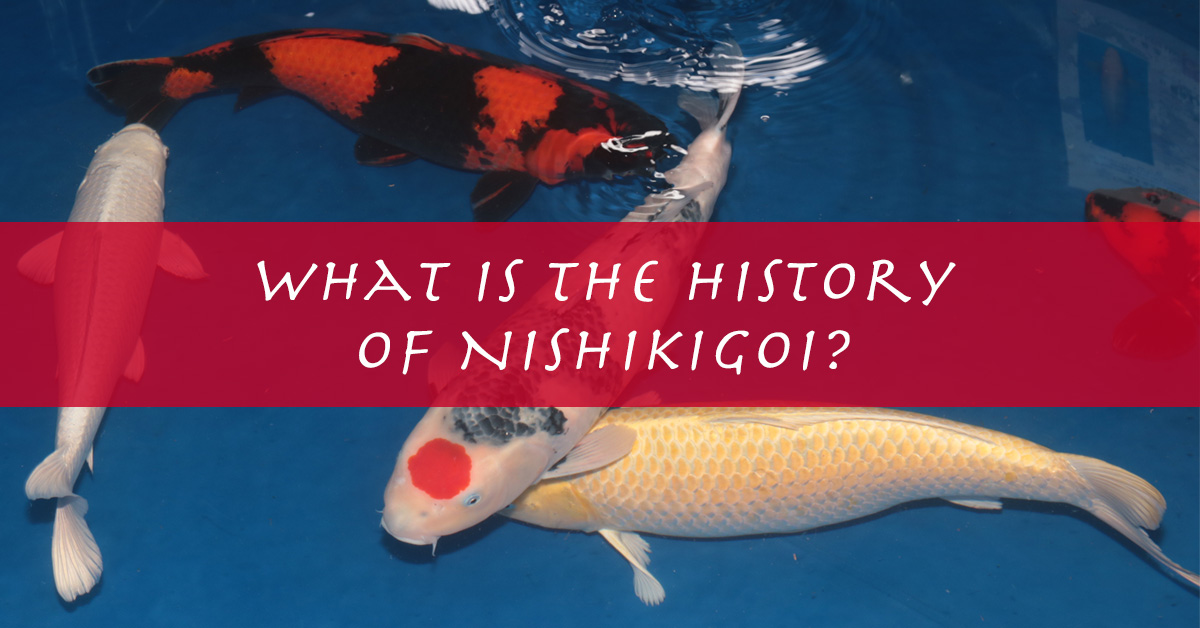
Learn the history of koi fish (Nishikigoi) and how they came to be such beautiful living jewels. Read about their Japanese origins from the carp and the long selective process that has created such strong body forms with vibrant colors.
Defining Nishikigoi: Japanese Koi Fish
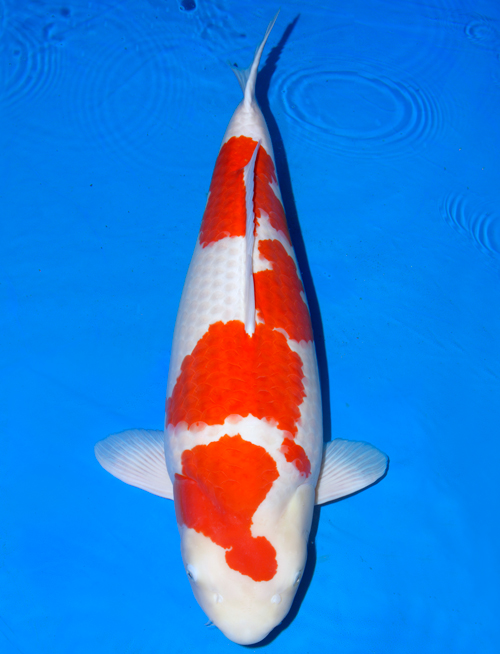
The name, “Nishikigoi” was a term first used as far back as 200 years ago in a village from the Niigata prefecture in Japan.
The first Nishikigoi was produced by farmers breeding black carp (or Magoi) as a food source to survive severe winter weather conditions, the result born from this was a vibrantly colored carp with an admirable figure that stood out from the rest with it’s rare beauty. As awareness grew, many started to appreciate Nishikigoi like a fine work of art.
Koi is a homophone for another word that means “affection” or “love” in Japanese; koi are symbols of love and friendship in Japan among many other symbols.
Koi are becoming a universal symbol of peace all over the world.
By the Heian period (794-1185), koi fish were already popular and kept by nobles in Japan. The nobles enjoyed feeding their koi with “Fu“, which was treated as a precious food source and is still eaten by people today. Koi were said to calmly come up to the surface when they sprinkled the Fu, never scrambling in greed. Sharing both the precious Fu and observing the modest behavior of the fish, people nurtured a peace in their heart. This was a gentleness that could be passed along from child to child, and has been ever since.
In the present, it is rather hard to find a country that has no koi hobbyists in it. People all over the world are attracted by the koi’s “peaceful” and “friendly” characteristics. The therapeutic effects of observing and interacting with fish is widely cherished, watching them swim is melodic and relaxing. Since koi are freshwater fish, you can create a relaxing koi fish garden almost anywhere.
The Meaning of Nishikigoi
Known as the  “swimming (or living) jewel”, the unique name for this koi fish comes from the Japanese word “nishiki” which traditionally means beautiful or elegant things.
“swimming (or living) jewel”, the unique name for this koi fish comes from the Japanese word “nishiki” which traditionally means beautiful or elegant things.
In ancient Japan, there were 4 treasures Kin(gold), Gin(silver), Sango(Coral), and Aya Nishiki(figured brocade), and it is said that the name “Nishiki-goi” is named after “Aya-Nishiki”. Nishikigoi is also commonly likened to the multi-colored brocade patterns of the Japanese traditional woven silk fabric, “kimono,” known for its vivid yet delicate colors and striking beauty.
“Ggoi” or koi is what the Japanese refer to simply as carp fish which is meant to be eaten. So you might say that Nishikigoi means “living jewel koi”
Originally created to be a consistent food source in Japan, these carp or koi soon evolved into an ornamental fish that many kept in their garden ponds to add beauty or shine.
As the concept of these “living jewelry” expanded, the koi soon began to symbolize success, ambition, perseverance, and advancement in life. It is said that to be a Nishikigoi is to be a fish that succeeds in life.
Therefore, Japanese people building homes would add a pond in their garden and keep Nishikigoi there as a way to mean that the master of the house feels fulfilled. We of course recommend that you buy our Japanese koi fish for sale to truly discover how they can add more beauty and balance to your home.
Japanese Koi History & Origins
It all started with the mutation.
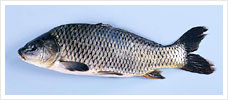
In Nihon shoki (the oldest chronicles in Japan), it is described that, in 720 AD, Emperor Keiko, the 12th emperor of Japan, swung by “Kuguri No Miya” to appreciate Koi on his way to Gifu prefecture with his vassals. It is said the Koi that emperor Keiko appreciated were mainly black color koi and a few red Koi. So where did such a red Koi come from? They were actually produced by a natural mutation and then gradually selected and bred.
Originating from the Yamakoshi Village and Ojiya City, the first Nishikigoi offspring from Magoi carp displayed red and yellow colors along with patterns.
As residents noticed this change, they started selective breeding into Niigata’s fertile soil and climate, which further grew the beauty and variety of the fish. After numerous attempts, Japanese koi became known in the present world as the “swimming jewel” they are today.
Through a labor intensive and highly selective process, Nishikigoi are raised in both outdoor and indoor conditions which are monitored closely. These Nishikigoi are regularly evaluated individually to find the brightest and finest patterns.
Carp were first bred for color mutations over a thousand years ago in China where the breeding led to development of goldfish.
The world was not aware of koi color variations in Japan until the early 1900’s when koi were exhibited in Tokyo, Japan. From this original set of koi, all other Nishikigoi viarities have been created and has evolved into a social hobby fort many pond owners. Many hobbyists passionately join local koi clubs to share knowledge of fish and pass on to future generations. It is important to our family that the culture continues to grow and thrive.
It is proven that water quality is critical to keeping these growing fish healthy, that is why many breeders in Japan use only the highest quality supplies for pond care and maintenance. To create a strong body form in Nishikigoi and vibrant colors, many breeders also use koi food that keeps the koi happy and glowing.
Recommended Pond & Koi Care Supplies for Nishikigoi
For all your Nishikigoi and pond needs, Kodama Koi Farm & Supply curates top quality products and supplies that many Nishikigoi breeders or farmers use.
From pond filters to color enhancing color food, find all you need to raise a bright and beautiful living jewel at Kodama Koi Supply. Or if you would rather purchase in person, stop by one of our Kodama Koi Garden pond retail store locations. These trusted products are flown in straight from Japan and handpicked for you.
How Many Varieties Of Nishikigoi Are There?
With around 200 varieties of Nishikigoi to choose from; the most popular classification is Gosanke which is made up of Kohaku, Taisho Sanshoku Sanke, and Showa Sanshoku varieties. Farmers and breeders of Nishikigoi expanded the categories of Nishikigoi so that some would display only certain colors and markings on the koi fish body as pure “peasant art.”
With this artistic expression, the different ways to describe Nishikigoi expanded to the words: heroic, sturdy, magnificent, vigorous, tremendous, an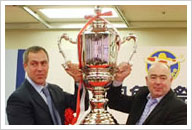 d more.
d more.
Soon, these living jewels caught the eyes of more than just the Japanese. This culture created by Japan’s nature and craftsmanship helped to expand the beloved concept of “Nishikigoi” globally. The popularity of Nishikigoi grew beyond Japan that koi lovers worldwide were hosting, participating, and winning championships at koi shows.
These championships and the nishikigoi themselves are so beloved, they were started to be seen as the national fish of Japan.
The All Japan Koi show, which is a very old and yearly nishikigoi show, is visited by overseas and local very important people. Even the Japanese imperial family visits! Every year, more than 4000 Koi fish are gathered from all over Japan only. 40 years ago, they put a subtitle for the Koi show as “Kokugyo no Saiten”, 国魚の祭典, saying “festival of national fish”, and this is the moment when they started regarding the Nishikigoi as their national fish.
View all different types of koi varieties!
The Beauty Of This Living Jewel
As the varieties expanded with differing levels of quality, Nishikigoi started being distinguished by their coloration, patterning, and scalation. In many koi shows, Nishikigoi are judged by these distinguishing qualities along with body conformation or shape and how it swims.
“Koi is the only products that values by beauty, not by its weight.” – Mamoru Kodama
Body conformation refers to the shape and size of the Nishikigoi. It is known in the world of koi appreciation that an ideal body is full and rounded in a spindle-like shape. The quality of a Nishikigoi refers to the koi fish’s skin. A common example is that a Kohaku should have snowy white skin with vivid Hi patterns. Meanwhile, the patterns showcased on Nishikigoi is what makes them attractive. These dynamic patterns should be well-balanced and bring out the uniqueness of each Japanese koi fish to catch the eyes of the public.
Story of Color Unleashed from the Dark – In the Niigata winter, there is no boundary line between sky and ground. All they see is gray color of the snow and cloudy sky, so they hardly see the bright colors from the scenery. Moreover, in Edo period (1603-1868 CE) when the first Nishikigoi appeared, people’s outfit was restricted as they can only wear subdued-colored cloths such as dark blue. It doesn’t surprise me even a guy unleashed from the grey world to the bright shiny world becomes a gifted artist.
VIDEO – Nishikigoi Fish as Art
Keys To Japanese Koi Appreciation
Among the many varieties of Nishikigoi that are judged at competitions, there are different things to look for based on the classification of koi being observed. All koi are judged based on their colors (Hi, Shiroji, and Sumi) along with their degrees of finish, body size, and steps in the patterns among other things.
 When looking at Kohaku koi, this popular type of Nishikigoi is commonly judged based on their red Hi pattern and pure white Shiroji. While looking at Tancho koi, they are judged based on their how round their Maruten, or round spot on the head, is and their white Shiroji quality. As for Showa koi, these majestic koi are judged according to their red Hi patterns, white Shiroji, and black Sumi as a whole.
When looking at Kohaku koi, this popular type of Nishikigoi is commonly judged based on their red Hi pattern and pure white Shiroji. While looking at Tancho koi, they are judged based on their how round their Maruten, or round spot on the head, is and their white Shiroji quality. As for Showa koi, these majestic koi are judged according to their red Hi patterns, white Shiroji, and black Sumi as a whole.
With brilliant colors and a dynamic body conformation, the refined beauty of this living piece of art helped to grow koi appreciation around the world. Many Japanese koi fish showcase refined colors that create a unique allure. They also feature a strong shine and many different colors from various varieties, each possessing its own unique glow and charm.
The appeal of Nishikigoi deepens with their graceful swim, especially the grace that comes from a koi fish with a large body. That is why they are aptly named the “swimming jewel” which describes these large beautifully colored koi swimming elegantly.
When these koi fish unite, a different kind of splendor is created. They herd together one moment before pulling away from each other the next for a breathtaking scene of color, grace, and beauty. No other aquarium fish around the world can offer such enjoyment.
With the glamorous colors, magnificent bodies, and elegant swimming; Japanese koi fish are a feast for the eyes whether they’re alone or in a pond.
What are the True Colors of Nishikigoi?
You can see red, black, blue, yellow and various other colors on koi that are swimming in the ponds of Hilton Hawaiian Village Hotel and Ala Moana shopping center in Hawaii. The name “Nishikigoi” came from these colors. I believe you should know about the true color of Nishikigoi.
The pigments that are kept in the skin cells will give Nishikigoi different colors like red, black, blue, etc. We can separate these pigments in 2 groups; red and black. The red group is called Carotenoid, and the black group is Melanin. There are about 20 different kinds of Carotenoid pigments that are found in fish. However, Nishikigoi has only 3 kinds; Lutein, Zeaxanthin and Astaxanthin. These pigments are kept in the koi’s skin surface to make them look red. These red pigments are not produced by koi. Koi absorb these pigments from their food and keep them in the pigment cells.
The koi that are sold in stores are fed color enhancement food (color-up food) to get bring out pigments. There are foods that don’t contain anything to enhance the color. These foods will not enhance your koi’s color. You should check to see the contents of koi food before you feed your koi. At Kodama Koi Farm, we feed our koi – Kodama Koi Food Color Up.
The pigment called Melanin is being produced in koi. Black is protective coloration for koi. Therefore, the color changes according to where they live. If they are in a dark place, their color will be pitch-black. If they are in a brighter place, their color will become grey. Koi change their color instantly depending on the circumstance. However, this only applies to Magoi that live in natural rivers and mud ponds. The black color on Nishikigoi wouldn’t change because they are improved varieties.
Have you seen the blue color koi at Ala Moana shopping center? That blue color is also because of the Melanin pigment. Why does black pigment create blue color? Well, do you know why the ocean in Hawaii looks blue? The water prism makes the dark color of bottom of the sea look blue to your eyes. The same happens to koi. The skin of the koi works like the prism to make the black Melanin color blue to your eyes.
Add Nishikigoi & Japanese Beauty To Your Pond
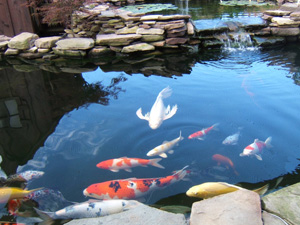 The best way to complement any pond or water garden is to add Nishikigoi. Known for their inspiring beauty, there is a real thrill when watching these Nishikigoi intermingle with each other.
The best way to complement any pond or water garden is to add Nishikigoi. Known for their inspiring beauty, there is a real thrill when watching these Nishikigoi intermingle with each other.
The cocktail of colors is truly magnificent, especially if there is a good blend of varieties and colors. From observing a single Nishikigoi to watching them swim together in a pond, this “ever changing beauty” is another way to appreciate Japanese koi fish. You may consider how a luxury interior designer or an outdoor landscaper would approach the beauty of koi in the home.
The elegant swim of these Nishikigoi varieties creates a picturesque beauty, depicting the vibrant colors for all of Japan’s four seasons. To ensure a long and healthy life for your Nishikigoi, keep their colors glowing all year long by using high quality koi food for color and growth.
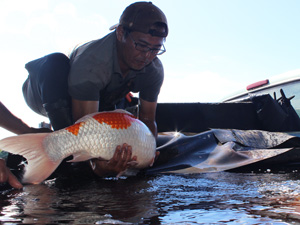 View Nishikigoi Available from Kodama Koi Farm
View Nishikigoi Available from Kodama Koi Farm
Turn your pond into a showcase of this ever changing beauty. Explore the many varieties of Nishikigoi that Kodama Koi Farm offers to add inspiring beauty to your pond or water garden.
Recommended reading on our other site Kodama Koi Garden:
- Understanding Koi Clay, Minerals, & Vitamins from Japan
- Feed Koi Fish Like Japanese
- Choose Hi Silk For Big And Healthy Koi
- Understanding Koi Pond Filter Systems
- Tips for Preparing Your Koi Pond For Spring
- Koi Food Guide: Maximize Color & Growth of Koi Fish
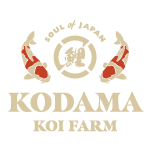
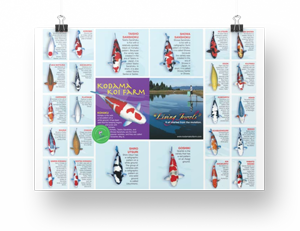

Do you hold koi for a fee until my pond is ready
Hi,
We can board your koi for you. Please contact our customer service department for more information.
Question? WHY is my koi is blown up and it’s gold color is fading. And turning white, is there anything to do for it.? thank you.
I know it is late to respond, but I will leave my comments anyway. Without getting more info, it is hard to reply, but it seems to be an health issue of your Koi. If you see this kind of condition, you should take pictures and talk to your local Koi dealers or vets.
I’m still waiting for my tank to arrive before buying koi
I have a desk mat right now with koi theme. may I know what type of breed the koi in my mat is? is it butterfly koi? I’ll try to find a koi nearest look as this.
https://officedeskmat.com/collections/gaming-desk-mats/products/spring-koi-fish-desk-mat
They look pretty, but I think they are both hirenaga longfin, but imaginary pictures. The right one can be Sanke or Showa
I don’t see any nets or strings over your natural outdoor ponds. How do you prevent birds from eating the koi’s?
Especially your lovely Japanese garden ponds.
Thanks.
Hello, at our farm, we do have strings over the farm and another nets over each pond where we keep all the babies.
Meeena ji
been dreaming of having koi carps. now, while waiting for the tank to arrive, I’m getting by with my koi themed desk mat 😂😂 having a zen with this during work to destress